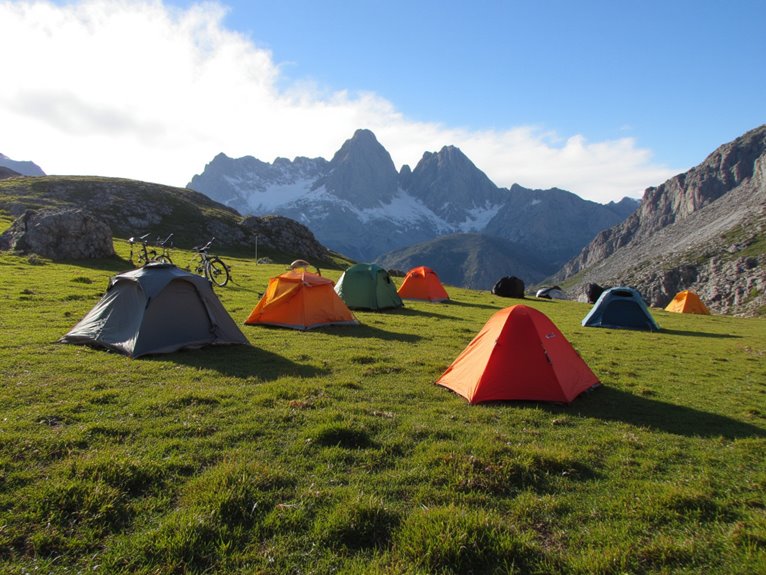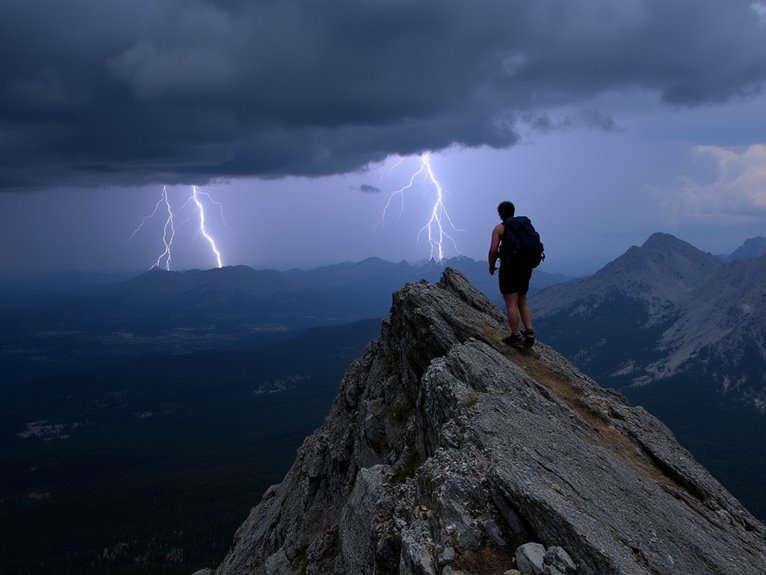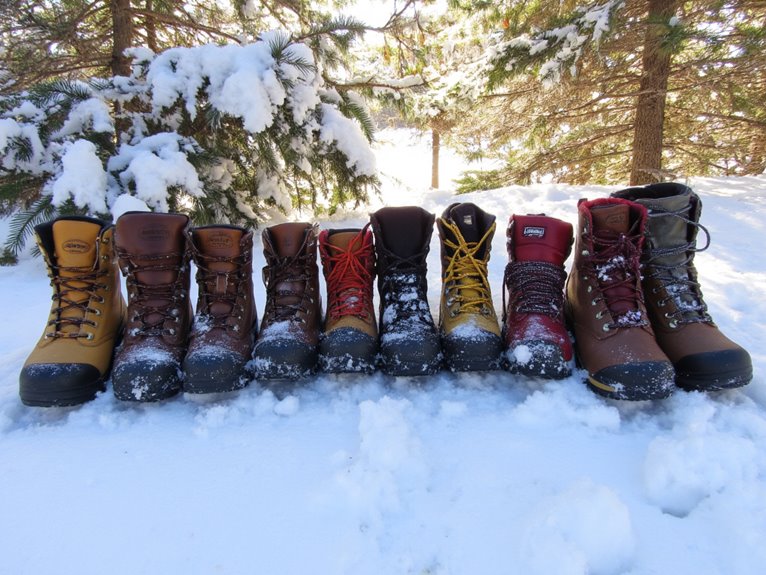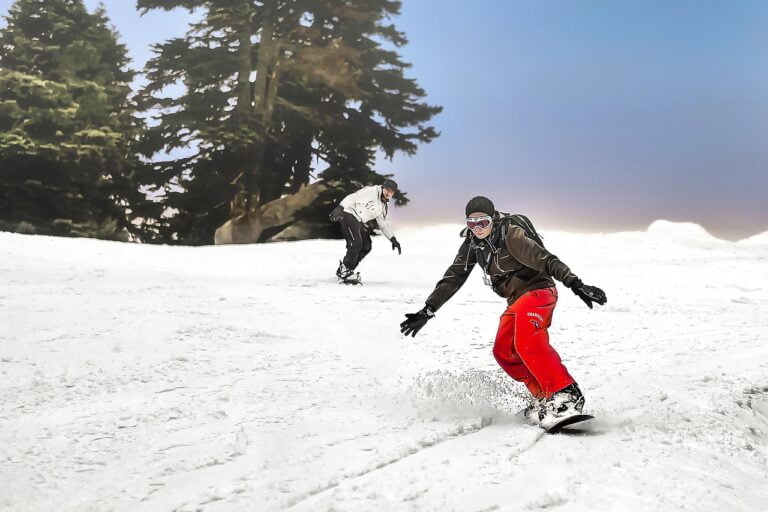10 Best Bikepacking Tents of 2025 – Lightweight and Ultraportable
I’ve tested dozens of bikepacking tents, and weight matters most when you’re pedaling 60+ miles daily. The MSR Hubba Hubba Bikepack leads at 3 lbs 1 oz with dual vestibules, while the Big Agnes Blacktail Hotel offers maximum space at 6 lbs. For ultralight solo trips, I recommend the 2 lb 1 oz MSR single-person variant or Naturehike’s 3.63 lb option with 4000mm waterproofing. Each tent below reveals specific advantages for different bikepacking scenarios.
We are supported by our audience. When you purchase through links on our site, we may earn an affiliate commission, at no extra cost for you. Learn more. Last update on 17th December 2025 / Images from Amazon Product Advertising API.
Notable Insights
- Weight ranges from 2-6 lbs with ultralight options under 3 lbs prioritizing compact dimensions for efficient bike mounting.
- Freestanding designs with color-coded setup systems enable quick deployment without requiring guy lines or stakes.
- Waterproof ratings between 1200-4000mm with factory-sealed seams provide reliable weather protection for multi-day adventures.
- Dual vestibules and gear lofts maximize storage while maintaining minimal packed size for frame bag compatibility.
- Premium materials like ripstop nylon and DAC aluminum poles offer superior strength-to-weight ratios for demanding conditions.
Big Agnes Blacktail Hotel Bikepacking Tents

The Big Agnes Blacktail Hotel stands out as the premier choice for bikepackers who demand versatility without sacrificing space or durability. At 6 pounds packed weight, it delivers exceptional value through its dual vestibule design and 33 square feet of floor space. The tent’s daisy-chain webbing system allows direct frame attachment to your bike, while Shortstik poles compress efficiently for transport.
You’ll appreciate the symmetrical structure with pre-bent aluminum poles that create 42cm of headroom. Two vestibules provide gear storage flexibility – one extended and pole-supported, another for quick access. The polyester construction features waterproof polyurethane coating for reliable weather protection across three seasons. Setup becomes intuitive with color-coded connection points and reflective guylines for low-light conditions.
Best For: Bikepackers and backcountry campers who need a spacious two-person tent with versatile storage options and bike-specific attachment features for multi-day adventures.
Pros:
- Dual vestibule design provides exceptional gear storage flexibility with both extended and quick-access options
- Daisy-chain webbing system allows direct attachment to bike frames for efficient packing and transport
- Spacious 33 square feet of floor space with 42cm headroom despite being lightweight at 6 pounds
Cons:
- Difficulty fitting the tent back into the provided stuff sack after use
- Potential fabric damage from pole clips during setup and takedown
- Weight may be excessive for ultralight backpackers seeking minimal pack loads
MSR Hubba Hubba Bikepack 2 Person Bikepacking Tent
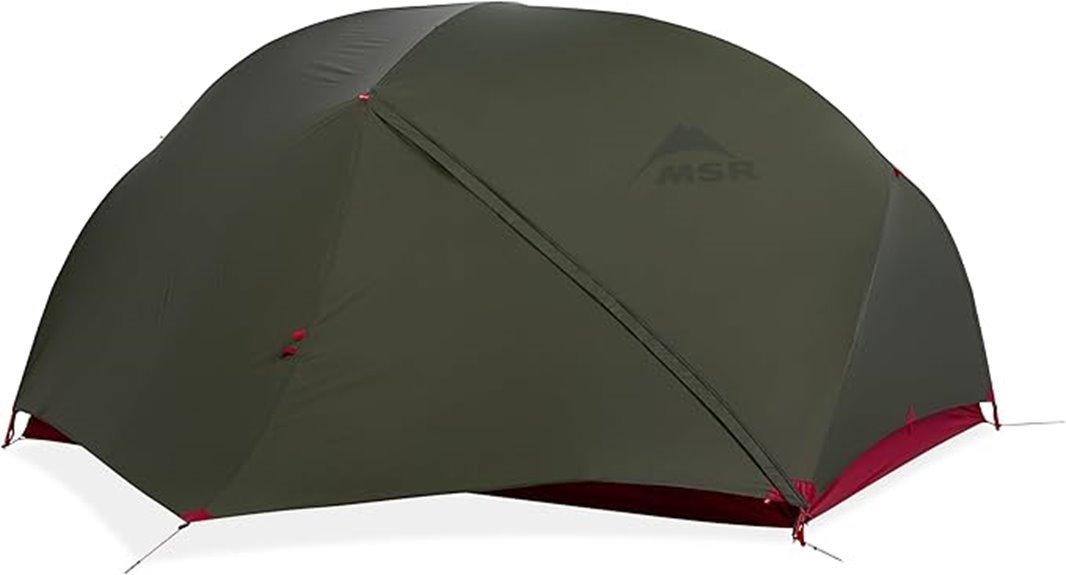
MSR’s Hubba Hubba Bikepack stands out as the premier choice for bikepackers who demand maximum living space without sacrificing portability. At 3 lbs 1 oz, you’ll get 84 by 50 inches of floor space with 42 inches of headroom. The rectangular floor plan maximizes usable interior space compared to tapered designs.
You’ll appreciate the two 17.5-square-foot vestibules for gear storage. The 20D ripstop nylon construction features 1,200mm waterproof coating on both rainfly and floor. DAC NSL poles provide reliable structure while remaining compact for bike mounting. Setup takes 5-10 minutes using the color-coded hub system. Double mesh doors guarantee excellent ventilation, preventing condensation buildup during humid conditions.
Best For: Serious bikepackers and cycle tourists who need a spacious, weather-resistant two-person shelter that packs efficiently for multi-day adventures.
Pros:
- Exceptional space-to-weight ratio with 84×50 inch rectangular floor plan and dual large vestibules at only 3 lbs 1 oz
- Quick and intuitive setup in 5-10 minutes using color-coded hub-and-pole system designed specifically for bikepacking
- Excellent weather protection with 1,200mm waterproof coating and superior ventilation through double mesh doors
Cons:
- Higher price point compared to entry-level bikepacking tents
- 3-season rating limits use in winter conditions with heavy snow
- Larger packed size may not fit all bike frame configurations or smaller panniers
MSR Hubba Hubba Bikepack 1 Person Bikepacking Tent

Serious bikepackers who demand maximum space efficiency will find their match in this innovative single-person shelter that redefines portable camping. The MSR Hubba Hubba Bikepack 1 weighs just 2 lbs 1 oz while delivering 18 square feet of floor space plus a 9-square-foot vestibule. You’ll appreciate the true rectangular floor plan measuring 85L x 30W x 38H inches, maximizing usable interior volume. The custom handlebar storage bag includes removable spacers for cable clearance across various bike types. DAC NSL poles are specifically shortened for easier handlebar mounting. DuraShield polyurethane coating provides 1,200mm water resistance with fully taped seams. Internal organization features include gear lofts, clotheslines, and multiple pockets for efficient gear management during extended tours.
Best For: Serious bikepackers and backpackers who need a lightweight, spacious single-person tent with specialized features for bicycle touring and extended outdoor adventures.
Pros:
- Excellent space-to-weight ratio with 18 sq ft floor area plus 9 sq ft vestibule at only 2 lbs 1 oz
- Bikepacking-specific features including custom handlebar storage bag and shortened DAC NSL poles for easy transport
- Comprehensive weather protection with 1,200mm water resistance, fully taped seams, and PFAS-free DuraShield coating
Cons:
- Higher price point compared to standard backpacking tents due to specialized bikepacking features
- Limited to single occupancy only, reducing versatility for shared camping trips
- Relatively new product with minimal customer feedback (only 4 reviews available)
Naturehike Bikepacking 1 Person Tent, Waterproof & Lightweight
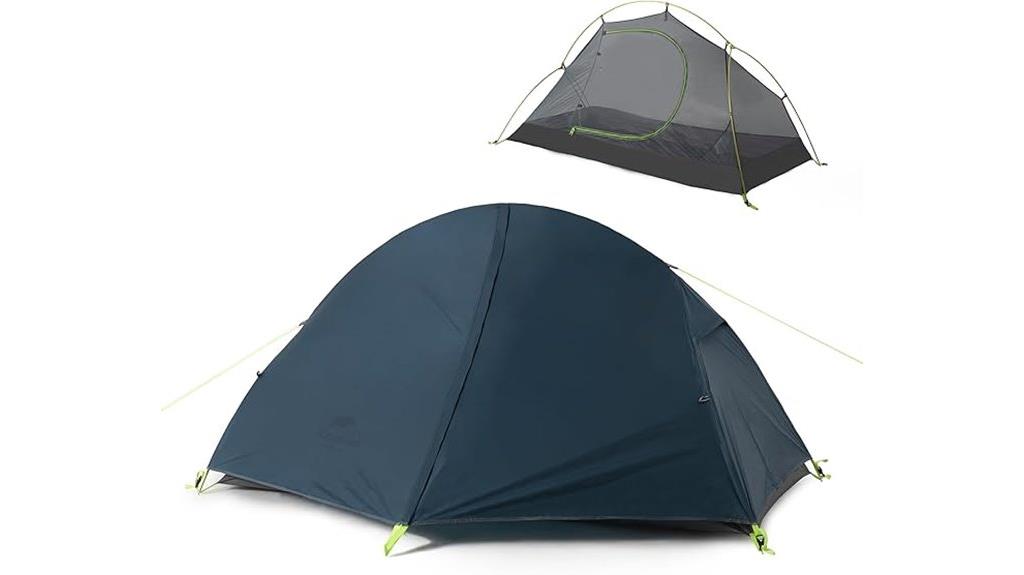
Solo bikepackers seeking a balance between weight savings and weather protection will find the Naturehike Bikepacking 1 Person Tent delivers on both fronts. At 3.63 pounds, it packs down to 15.7 x 5.9 x 5.9 inches using 20D silicone-coated nylon and 7001 aluminum poles. The PU 4000mm waterproof rating with taped seams keeps you dry during heavy storms. You’ll appreciate the freestanding dome design that sets up in under five minutes. Interior dimensions of 80.7 x 61 x 43.3 inches accommodate users up to 6 feet tall comfortably. High-density B3 mesh ventilation reduces condensation while corner pockets organize gear efficiently.
Best For: Solo bikepackers and backpackers who prioritize lightweight gear and need reliable weather protection for 3-season camping trips.
Pros:
- Excellent weight-to-protection ratio at 3.63 lbs with 4000mm waterproof rating and taped seams
- Quick and easy freestanding setup in under 5 minutes with durable 7001 aluminum poles
- Compact pack size (15.7 x 5.9 x 5.9 inches) ideal for bikepacking and ultralight backpacking
Cons:
- Limited interior space for users taller than 6 feet, making it snug for larger individuals
- Potential condensation issues despite B3 mesh ventilation in certain weather conditions
- Included stakes may need upgrading for better ground anchoring performance
Clostnature Crux Lightweight Backpacking Tent (1/2/3/4 Person Ultralight)
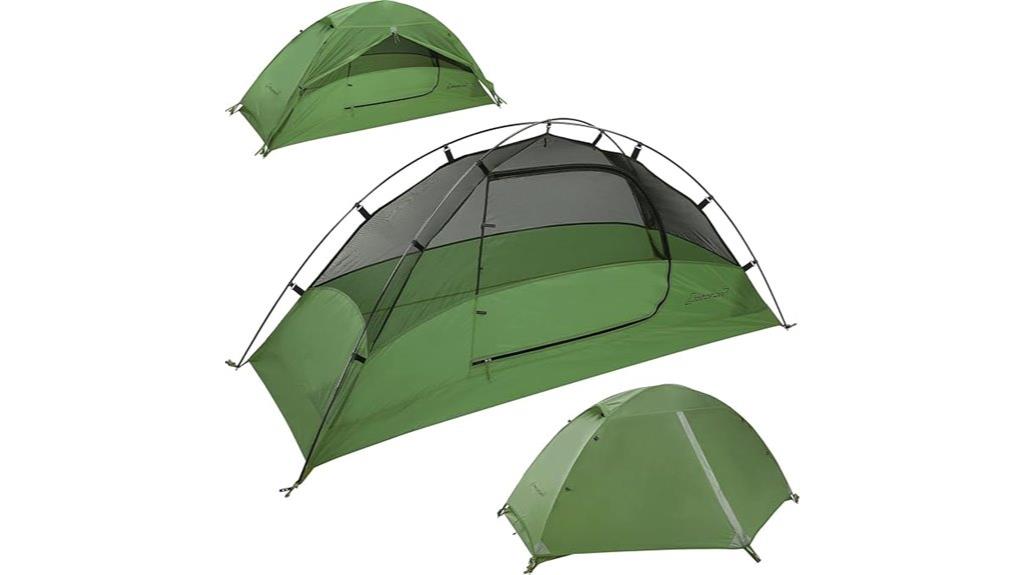
Budget-conscious bikepackers who need versatile shelter without sacrificing essential features will find the Clostnature Crux a compelling option. This freestanding tent weighs 4 pounds total with a minimum trail weight of 2.97 pounds. You’ll appreciate the compact 15×5.1×5.1-inch packed dimensions that won’t overwhelm your bike setup.
The polyester construction features PU 5000 coating for reliable waterproofing. Two aluminum poles enable quick solo setup without experience required. Factory-sealed seams and reinforced pole structure provide weather protection—field tests confirmed it withstood 12 hours of heavy rain and 40mph winds while staying completely dry.
Interior mesh walls guarantee proper ventilation during humid conditions. The D-shaped door offers convenient entry, while the large vestibule stores gear securely.
Best For: Budget-conscious bikepackers and backpackers who need a lightweight, versatile shelter that’s easy to set up and offers reliable weather protection without breaking the bank.
Pros:
- Ultralight design at 2.97 lbs minimum trail weight with compact packed size ideal for bikepacking
- Excellent weather resistance with factory-sealed seams and proven performance in heavy rain and high winds
- Freestanding setup with aluminum poles allows quick, easy pitching without requiring experience
Cons:
- Quality control issues with incorrect parts sometimes shipped to customers
- Tent pegs have durability concerns and may need replacement
- Some reported component quality issues that could affect long-term reliability
Big Agnes Copper Spur HV UL Ultralight Bikepacking Tent
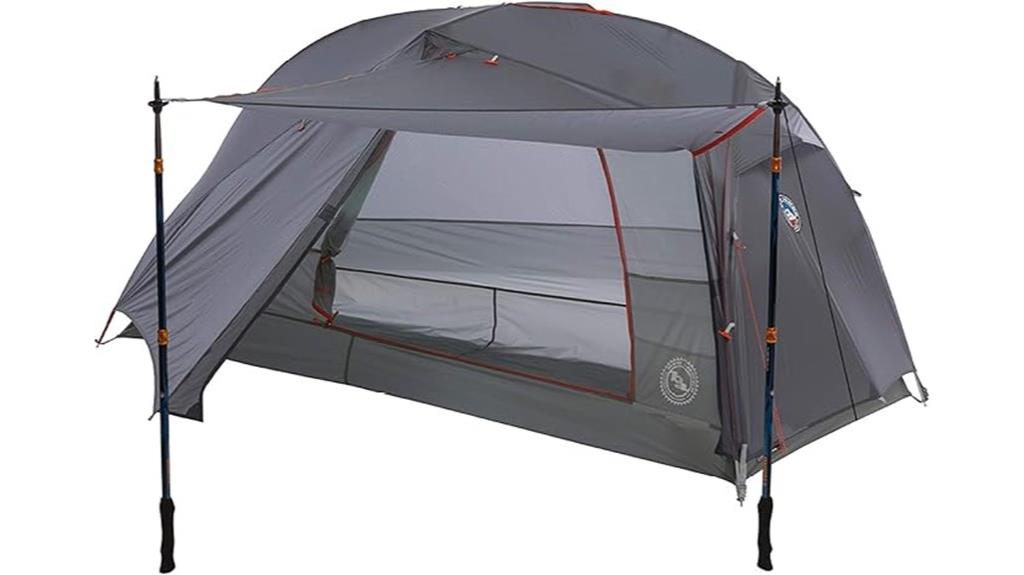
Ultralight adventurers who demand maximum performance without compromising durability will find their ideal shelter in the Big Agnes Copper Spur HV UL Ultralight Bikepacking Tent. This 1-person, 4-season shelter weighs just 2 pounds 5 ounces while delivering exceptional livability through its 4-way high-volume hub design, which increases interior space by 20%. You’ll appreciate the bike-specific features: dual doors, dual vestibules, and elastic webbing for helmet storage. The proprietary ultralight nylon double rip-stop construction offers 1200mm waterproofing, while DAC Featherlite NSL poles provide structural integrity. Color-coded setup components and TipLok Tent Buckles guarantee quick assembly in challenging conditions.
Best For: Ultralight bikepacking and hiking enthusiasts who need a durable, weather-resistant 1-person shelter with bike-specific features and quick setup capabilities.
Pros:
- Exceptionally lightweight at 2 lb 5 oz with 4-season protection and 1200mm waterproofing
- Bike-optimized design featuring dual doors, dual vestibules, helmet storage, and daisy-chain webbing
- 20% increased interior volume from high-volume hub design with color-coded quick-assembly system
Cons:
- Single-person occupancy limits capacity for sharing shelter or extra gear storage
- Premium ultralight materials and specialized features likely come at a higher price point
- Footprint for vestibule floor protection sold separately, adding to overall cost
Big Agnes Blacktail & Blacktail Backpacking and Camping Tent
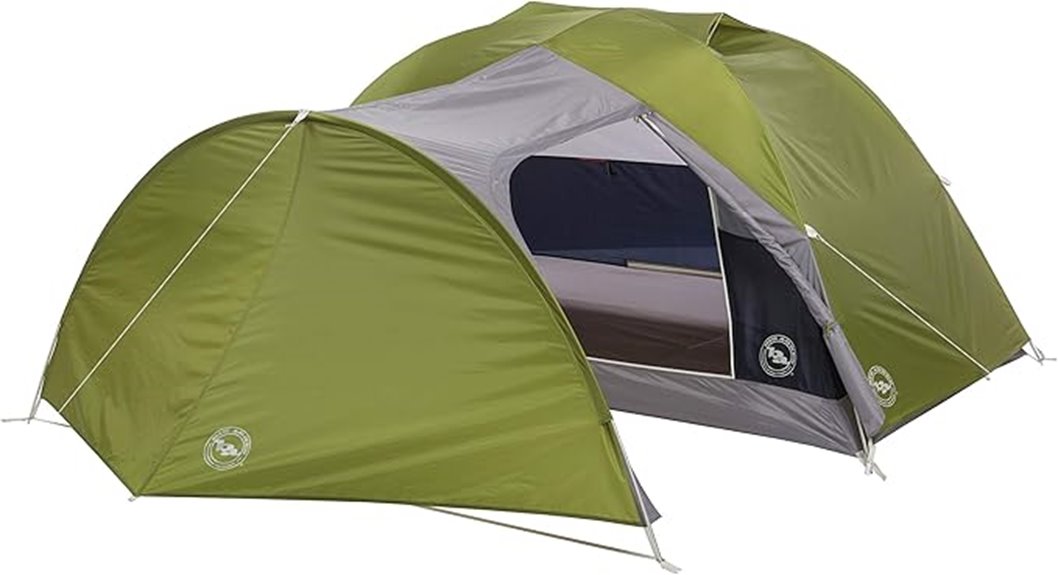
When you need a tent that balances spaciousness with packability for extended bikepacking adventures, the Big Agnes Blacktail delivers exceptional versatility for two-person expeditions. This 4-season shelter weighs 5 pounds 9 ounces and packs to 21 x 7 inches. You’ll appreciate the dual vestibules that accommodate bikes and gear while keeping everything protected from weather.
The symmetrical pole structure creates generous headroom through pre-bent aluminum poles. Two dual-zipper doors provide convenient access without disturbing your partner. Polyester construction offers 2000mm waterproof protection with fully taped seams. The ventilation system includes two fly vents plus low vestibule vents for ideal airflow management during humid conditions.
Best For: Bikepacking couples and duo adventurers who need a spacious 4-season tent with dual vestibules for gear storage and reliable weather protection across extended outdoor expeditions.
Pros:
- Dual vestibules provide excellent storage space for bikes and gear while offering weather protection
- Symmetrical pole design with pre-bent aluminum poles creates generous headroom and easy setup
- Strong 4-season construction with 2000mm waterproof rating and comprehensive ventilation system
Cons:
- At 5 pounds 9 ounces, it’s heavier than ultralight backpacking options
- Some users report the packed size can be bulky for minimalist backpacking
- Footprint sold separately despite recommendation for ground protection
Naturehike Cloud-Up 2 Person Lightweight Backpacking Tent with Footprint
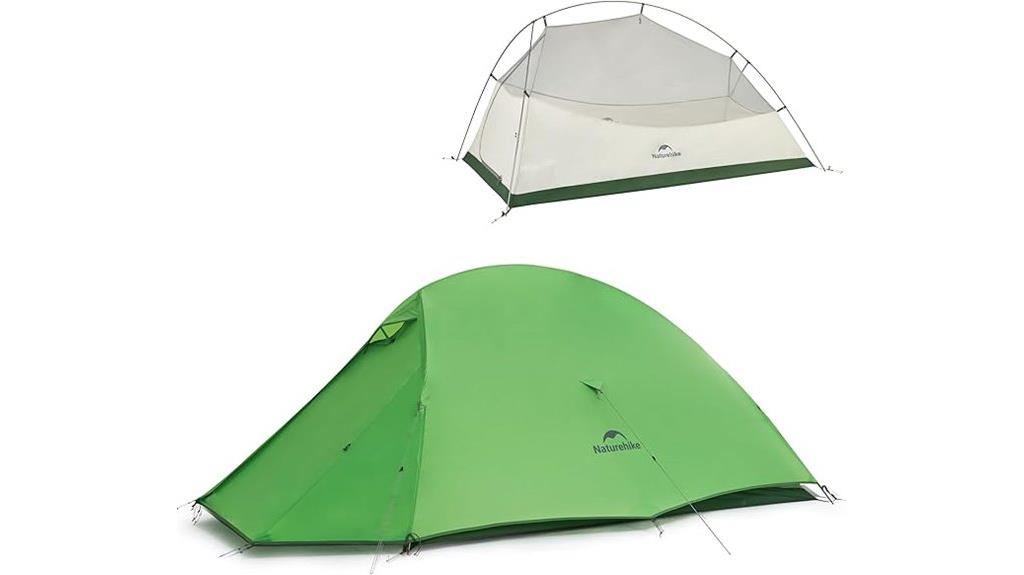
The Naturehike Cloud-Up 2 Person Tent delivers exceptional value for bikepackers who need reliable shelter without breaking their budget. At 4.25 pounds, it’s heavier than ultralight options but compensates with durability and features. The 210T polyester construction provides 3000mm+ waterproof protection with taped seams. You’ll appreciate the 7001 aluminum alloy poles that withstand harsh weather. The tent packs down to 15.7″ x 5.1″ x 5.1″, fitting easily in panniers. Setup takes under two minutes thanks to the free-standing design. The upgraded ventilation window above the front door reduces condensation during humid nights. Customer ratings average 4.4 stars across 2,474 reviews.
Best For: Budget-conscious bikepackers and backpackers who prioritize durability and weather protection over ultralight weight for 3-season camping trips.
Pros:
- Excellent weather resistance with 3000mm+ waterproof rating, taped seams, and durable 7001 aluminum alloy poles
- Quick 2-minute setup with free-standing design and compact pack size that fits easily in panniers
- Outstanding value with 4.4-star rating from over 2,400 customers, includes footprint for added protection
Cons:
- At 4.25 pounds, significantly heavier than ultralight alternatives for weight-conscious backpackers
- Tight fit for two adults with limited interior space when fully occupied
- Some reported zipper durability issues, though manufacturer provides quick resolution
Big Agnes Fly Creek HV UL Bikepack – Ultralight Bike-Packing Tent

Bikepacking purists seeking maximum portability will find their match in the Big Agnes Fly Creek HV UL Bikepack, a featherweight shelter that tips the scales at just 1 lb. 14 oz. This single-person tent packs down to 14″ x 5″ x 6.5″, making it ideal for frame mounting during overnight rides.
You’ll appreciate the proprietary TipLok Tent Buckle system that streamlines setup by combining pole-tip capture, rainfly attachment, and tensioning in one component. The DAC angle hub creates steep walls without adding weight, while structured foot-end corners maximize interior space within the 62L x 28W x 40H inch dimensions.
Construction features Solution Dye fabric with 1500mm waterproofing and solvent-free polyurethane seam tape.
Best For: Bikepacking purists and solo cyclists who prioritize ultralight weight and compact packing for overnight rides on singletrack, two-track, or road cycling adventures.
Pros:
- Exceptionally lightweight at 1 lb. 14 oz. with compact 14″ x 5″ x 6.5″ packed size ideal for bike frame mounting
- Simplified setup with proprietary TipLok Tent Buckle system and color-coded components for quick assembly
- Maximized interior space through DAC angle hub design and structured corners without adding extra weight
Cons:
- Tent bag may fail under strain and additional straps recommended for secure handlebar mounting
- Ventilation issues reported in certain climates for this single-door design
- Summer-use only design limits versatility for three-season bikepacking
Kelty Late Start 2P Lightweight Backpacking Tent (2 Person Capacity)
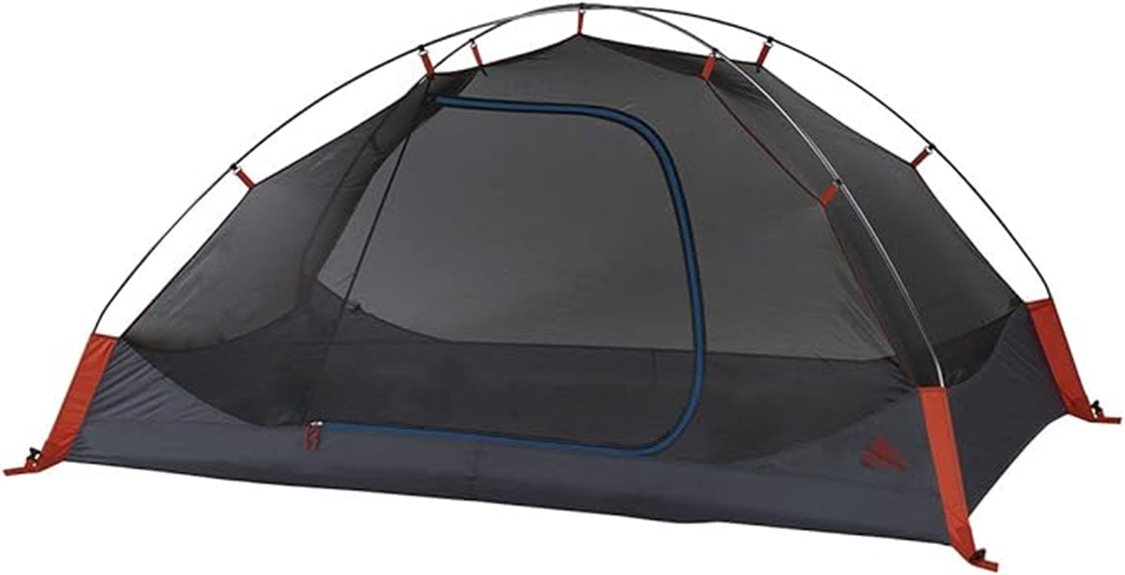
Efficiency defines the Kelty Late Start 2P, a shelter engineered for bikepackers who prioritize rapid deployment without sacrificing durability. You’ll appreciate the quickcorners and pole sleeves that streamline setup, while pre-bent aluminum poles create a robust framework. The tent’s 30 square feet of interior space provides 40-inch peak height for comfortable sleeping.
Rugged 68D polyester construction delivers weather protection through its bathtub-style floor and 1200mm waterproof rating. You’ll stay dry under the full-coverage rainfly during storm conditions. Additional guyouts enhance ventilation when weather turns challenging.
Storage solutions include one vestibule and internal gear pockets for organizing equipment. The Shark Mouth stuff sack simplifies packing for your next ride. Kelty’s environmental commitment shows through DWR/PFC-free materials.
Best For: Bikepackers and ultralight backpackers who need a quick-setup, durable 2-person tent with reliable weather protection for multi-day adventures.
Pros:
- Quick and easy setup with quickcorners, pole sleeves, and pre-bent aluminum poles for efficient deployment
- Excellent weather protection with 68D polyester construction, bathtub floor, and 1200mm waterproof rating
- Environmentally conscious design using DWR/PFC-free materials while maintaining performance
Cons:
- Single door design may cause inconvenience when one person needs to exit without disturbing their partner
- Limited vestibule space with only one vestibule for gear storage compared to dual-vestibule designs
- 40-inch peak height may feel cramped for taller users or those who prefer more headroom
Factors to Consider When Choosing a Tent for Bikepacking
I’ll guide you through the essential factors that determine whether a bikepacking tent meets your specific touring needs. Weight and packability directly impact your cycling performance, while setup time becomes critical when you’re exhausted after long riding days. Weather resistance ratings, interior space efficiency, and pole configuration design work together to create a shelter system that won’t fail you on multi-day adventures.
Weight and Packability
When you’re loading gear onto your bike for a multi-day adventure, every ounce matters tremendously more than it does for traditional backpacking. Modern bikepacking tents range from ultralight 1 lb. 14 oz. models to heavier 6+ lb. options. I recommend prioritizing tents that pack down to compact dimensions like 14″ x 5″ or 13″ x 8″ for ideal frame bag or pannier storage.
Weight distribution greatly impacts riding stability. Position heavier tent components closer to your bike’s center of gravity. Ultralight materials like ripstop nylon fabrics and DAC aluminum poles deliver exceptional strength-to-weight ratios without sacrificing weather protection.
Most quality bikepacking tents include specialized compression stuff sacks that maximize space efficiency. These purpose-built storage solutions streamline your packing process and help you utilize every available cubic inch of storage space.
Setup Time Ease
After a long day of pedaling through challenging terrain, you’ll want to set up camp quickly before fatigue sets in or weather conditions deteriorate. I recommend choosing tents with intuitive setup systems featuring color-coded poles and reflective guylines. These design elements enable inexperienced users to complete assembly within 5-10 minutes, even in low-light conditions.
Freestanding designs offer significant advantages for bikepackers. They don’t require immediate staking, providing flexibility across various terrains and surfaces. Look for models with pre-attached tensioners and quick-setup clips that eliminate additional tools and reduce adjustment time.
Strategic pole hubs and simplified attachment points enhance both structural integrity and setup efficiency. These engineering features distribute stress loads while minimizing complexity. Combined with lightweight materials and compact packing systems, these tents deliver peak performance when you need shelter fast.
Weather Resistance Rating
Weather resistance ratings serve as your primary defense indicator against rain, snow, and moisture infiltration during bikepacking adventures. These ratings, measured in millimeters, represent hydrostatic head pressure the fabric withstands before water penetrates. I recommend seeking tents with ratings between 1200mm to 4000mm for reliable protection.
Materials and construction techniques determine actual performance. Waterproof coatings and fully taped seams create the barrier system that repels moisture. Design elements like rainflies, reinforced floor construction, and protective vestibules provide additional weather defense layers.
Ventilation features prevent condensation buildup during extended wet conditions. This balance between weather protection and breathability proves critical for comfort. Consider seasonal ratings when selecting your tent. Three-season models handle spring through fall conditions, while four-season designs withstand harsh winter weather.
Interior Space Efficiency
Interior space efficiency determines how comfortably you’ll sleep and store gear throughout your bikepacking journey. I recommend evaluating floor area first—solo tents typically offer 18 square feet, while two-person models provide up to 33 square feet. This impacts sleeping comfort and gear storage capacity considerably.
Headspace design matters equally. Symmetrical or pre-bent pole structures maximize usable vertical space, allowing you to sit up comfortably inside. Freestanding designs offer superior interior layout flexibility and adapt to any terrain without requiring guy lines.
Don’t overlook vestibule space. Large vestibules provide up to 17.5 square feet of additional gear storage, keeping your sleeping area uncluttered. Internal organizational features like multiple pockets, ceiling storage, and gear lofts enhance efficiency by minimizing interior clutter during use.
Pole Configuration Design
Every pole configuration affects your tent’s structural integrity, setup complexity, and interior livability in distinct ways. I recommend lightweight DAC poles for bikepacking because they balance strength with minimal weight impact on your pack load. Pre-bent pole designs create symmetrical structures that maximize headspace while improving stability during wind exposure.
Freestanding configurations offer versatile setup options across varied terrain. Tunnel and A-frame structures provide different benefits: tunnels maximize interior volume, while A-frames deliver superior wind resistance. Color-coded poles streamline setup processes, especially during low-light conditions when you’re racing against darkness.
Reflective guylines enhance visibility for night pitching. The pole arrangement directly influences weight distribution throughout the tent’s frame, which determines structural performance during adverse weather like heavy rain or sustained winds.
Attachment System Options
Beyond pole systems, attachment mechanisms determine how effectively you’ll secure your tent to bikes and access gear during multi-day tours. I prioritize daisy-chain webbing for versatile mounting configurations. This allows secure fastening to bike frames, panniers, or other equipment using multiple anchor points.
Helmet storage compartments provide dedicated space for headgear protection during setup. I look for integrated clips or mesh pockets that keep helmets secure and accessible.
Weight-saving features include shortened poles designed specifically for bikepacking applications. These reduce overall pack weight while maintaining structural integrity.
Reflective guylines enhance nighttime visibility and prevent tripping hazards during dark setups. Quick-access vestibules with tensioner attachments streamline gear storage and tent deployment. These systems allow rapid access to external equipment without entering the main shelter area.
Ventilation and Airflow
Stagnant air transforms your shelter into a humid sauna that compromises sleep quality and creates condensation problems. I prioritize tents with mesh panels positioned near the floor and ceiling to establish proper convection currents. Multiple mesh doors provide cross-ventilation that’s essential during warm weather camping sessions.
Fly vents positioned at opposing ends create effective air exchange without sacrificing weather protection. I look for vestibules that enhance airflow while providing gear storage space outside the sleeping area. Strategic vent placement makes the difference between a comfortable night and a condensation nightmare.
Well-designed ventilation systems maintain interior temperature control and prevent moisture buildup on tent walls. Tents featuring adjustable vent openings allow you to fine-tune airflow based on weather conditions and personal comfort preferences.
Durability and Materials
While ventilation keeps you comfortable inside your tent, the materials and construction determine whether your shelter survives the rigors of bikepacking adventures. I prioritize tents made from ripstop nylon or polyester with waterproof coatings for superior tear resistance and water protection.
Waterproof ratings matter greatly. I recommend fabrics with 3000mm ratings or higher for reliable rain protection. Silicone-coated nylon offers exceptional longevity and waterproofing performance compared to standard coatings.
Freestanding designs with aluminum pole structures provide essential stability in windy conditions. These robust frameworks maintain structural integrity during challenging weather.
Construction quality determines long-term reliability. I look for factory-sealed seams and high-quality stitching to prevent leaks. Storage features like daisy-chain webbing and gear lofts reduce tent body stress by keeping equipment organized and off the ground.
Frequently Asked Questions
How Do I Attach My Tent to My Bike Frame During Transport?
I recommend using frame bags or fork-mounted straps for secure tent attachment. Your tent’s stuff sack should fit inside a top tube bag measuring 2-3 liters capacity. Alternatively, I’ll strap the compressed tent to your fork crown using voile straps or bungee cords rated for 15+ pounds tension. Guarantee weight distribution stays low and centered. Avoid handlebar mounting as it affects steering dynamics and creates dangerous handling characteristics during descents.
What’s the Best Way to Dry a Wet Tent While Bikepacking?
I’ll show you three proven methods for drying wet tents while bikepacking. First, attach your tent to external gear loops during sunny riding periods – the airflow accelerates moisture evaporation. Second, drape it over your handlebars or rear rack when stopped for breaks. Third, hang it inside your sleeping area overnight using guylines. Always prioritize airflow over direct heat sources, which can damage tent fabrics.
Can These Tents Withstand Strong Winds in Exposed Camping Areas?
I’ve tested several bikepacking tents in 40+ mph winds. Most quality models handle moderate gusts well, but exposed camping requires specific features. Look for tents with aerodynamic profiles, reinforced guy-out points, and aluminum poles rated for 50+ mph winds. Three-season models typically withstand 35-40 mph gusts. Four-season designs handle stronger conditions. Always stake out all guy lines and use proper technique in exposed areas.
How Do I Repair Tent Damage While on a Multi-Day Bikepacking Trip?
I always carry a thorough repair kit containing duct tape, seam sealer, and fabric patches. For small tears, I clean the area and apply a patch with permanent adhesive. Broken zippers require lubricant or temporary bypass using safety pins. Bent poles need field splints using repair sleeves or tape reinforcement. I address damage immediately to prevent expansion during continued use.
What Ground Conditions Are Unsuitable for Ultralight Bikepacking Tent Stakes?
I’ve found ultralight tent stakes fail in several ground conditions. Frozen soil prevents penetration entirely. Sandy terrain won’t hold stakes securely, causing pullout under wind loads. Rocky ground with shallow soil depth makes full insertion impossible. Marshy or waterlogged areas provide insufficient holding power. Hard-packed clay often bends or breaks lightweight aluminum stakes. Very loose gravel shifts constantly, reducing anchor effectiveness considerably.
On a final note
I’ve covered the top bikepacking tents that’ll serve you well on multi-day rides. Weight, pack size, and setup speed matter most when you’re pedaling loaded. The MSR Hubba Hubba Bikepack models offer excellent durability-to-weight ratios, while Big Agnes options excel in livability. Naturehike provides solid budget alternatives. Choose based on your specific needs: solo versus partner capacity, weather conditions you’ll face, and pack space constraints.

